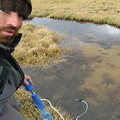 吉爾吉斯缺乾淨飲用水的狀況在近年內透過幾千萬美元的資金贊助下已逐漸解決了,然而評論者卻表示其結果頂多是好壞參半而已。
吉爾吉斯缺乾淨飲用水的狀況在近年內透過幾千萬美元的資金贊助下已逐漸解決了,然而評論者卻表示其結果頂多是好壞參半而已。
許多這些責難都是針對一些國際資金捐助者,這些捐助者付錢贊助擴大與維修鄉間水路網絡的一個主要計畫。但是一位乾淨飲用水計畫裡的專家卻表示大部分經營管理問題已經解決了,而現在的最大障礙是人民不願意為未來的維護費付一點小錢,因此這個計畫的供水系統將可能失去功能。
吉爾吉斯政府的衛生與疾病部門表示,全國500萬人口中至少有60萬人沒有獲得乾淨飲用水的管道,這造成像是斑疹傷寒及其他胃部不適等疾病的高罹患率。非官方估計的數據更高,他們估計全國約有半數人口存在此問題,在鄉村地區問題更嚴重,90%的村民無法取得乾淨而被適當處理的飲用水。
水與能源專家麥提夫(Ularbek Mateev)表示:「飲水供應狀況只有在首都比什凱克(Bishkek)是符合要求的,離開首都地區及偏遠的村落,民眾則直接由灌溉渠道(aryks)飲水」。「Aryks」是中亞地區灌溉用的傳統渠道。
在蘇聯瓦解後的17年間,吉爾吉斯政府因財務困窘無法加以投注資金,使水供應系統持續惡化。在許多有主要供水系統的地方,這些基礎建設經常都惡化到警戒邊緣,甚至還有好多地方從來不曾連上主要供水系統。
譬如吉爾吉斯東北邊喀拉口爾(Karakol)小鎮的人民有自來水,但卻必須等到水中泥沙沈澱且煮沸過後才能使用。而在邁利賽(Mailuu suu)的一個南方小鎮,沒有主要供水系統的民眾還要面對地下水被廢棄鈾礦場輻射廢棄物污染的風險。
相對於烏茲別克斯坦及土庫曼斯坦等乾旱且地處低窪的中亞邦國面對長年飲水短缺狀況,位居山區的吉爾吉斯卻因為有很多冰河及河川而有永不枯竭的水源,至少在理論上是如此。
 吉爾吉斯政府在2001年與外國贊助者進行合作,啟動2項改善取得乾淨水源的大計畫,這兩項計畫一般稱為塔扎賽(Taza Suu)或是乾淨水(Clean Water)計畫。亞洲開發銀行(The Asian Development Bank, 又稱ADB)是其中一項計畫的主要資金贊助者,她挹注該計畫4500萬美元成本中的3600萬美元來改善吉爾吉斯4個地區的鄉村水資源基礎建設。世界銀行(World Bank)及英國國際發展署(Department for International Development)提供3100萬美元給鄉村供水與環境衛生計畫(Rural Water Supply and Sanitation Project)來支助剩下的3個區域。
吉爾吉斯政府在2001年與外國贊助者進行合作,啟動2項改善取得乾淨水源的大計畫,這兩項計畫一般稱為塔扎賽(Taza Suu)或是乾淨水(Clean Water)計畫。亞洲開發銀行(The Asian Development Bank, 又稱ADB)是其中一項計畫的主要資金贊助者,她挹注該計畫4500萬美元成本中的3600萬美元來改善吉爾吉斯4個地區的鄉村水資源基礎建設。世界銀行(World Bank)及英國國際發展署(Department for International Development)提供3100萬美元給鄉村供水與環境衛生計畫(Rural Water Supply and Sanitation Project)來支助剩下的3個區域。
在進度稍微延遲之下,兩項計畫都預定在2008年12月31日時終止。
塔扎賽計畫的兩個部分都必須降低原來的期望,亞洲開發銀行所經營的計畫更因為營運方式而特別遭受當地施壓團體的批評。該銀行官員表示重要的關切之處已經被處理了,而其他甫發生的問題則將一邊進行一邊解決。
A shortage of clean drinking water in Kyrgyzstan has been tackled with multimillion dollar funding in recent years, but critics say the results have at best been mixed.
Much of the blame has been directed at the international donors who paid for a major program to expand and repair water networks in the countryside. But an expert working on the Clean Water program said that most of the management problems have been fixed, and the big obstacle now is people's reluctance to pay a small amount towards upkeep, so their supply system is liable to break down.
The government's hygiene and disease department says at least 600,000 people out of a total population of five million have no access to clean drinking water, leading to a high incidence of diseases such as typhus and other gastric illnesses. Unofficial estimates put the figure much higher at close to half the population, overwhelmingly in rural areas where nine out of 10 villagers do not have access to clean, properly treated water.
"The drinking water supply is satisfactory only in Bishkek," said Ularbek Mateev, an expert on water and energy issues. "Outside the capital and in remote villages, people drink water right from the aryks."
"Aryks" are traditional channels used for irrigation in Central Asia.
Provision has deteriorated in the 17 years since the Soviet Union broke up due to a lack of investment by Kyrgyzstan's cash-strapped government. In places where a mains water supply exists, the infrastructure has often deteriorated to an alarming extent, and there are also many areas that were never connected up in the first place.
For example, people in Karakol, a town in northeastern Kyrgyzstan, have running water but cannot use it until they have allowed the clay and sand to settle and then boiled the water. In the southern town of Mailuusuu, people without a mains supply are at risk from subsoil water contaminated by radioactive waste from defunct uranium mines.
Paradoxically, while arid, low-lying Central Asian states like Uzbekistan and Turkmenistan face a perennial shortage of water, mountainous Kyrgyzstan has, in theory at least, an inexhaustible supply, with massive glaciers and countless rivers.
In 2001, the Kyrgyz government, in conjunction with foreign donors, launched two big projects to improve access to clean water with the common title Taza Suu, or Clean Water. The Asian Development Bank, ADB, was the major funder of one of these projects, providing US$36 million of the US$45 million cost, to improve rural water infrastructure in four regions of Kyrgyzstan. The World Bank and Britain's Department for International Development provided US$31 million for the Rural Water Supply and Sanitation Project, covering the remaining three regions.
After some delay, both projects are due to end by December 31, 2008.
Both segments of the Taza Suu program have had to lower their expectations, and the ADB-run project in particular has faced criticism from a local pressure group for the way it was run. Officials at the bank say significant concerns have already been addressed and other teething problems are being dealt with along the way.
全文及圖片詳見:ENS







